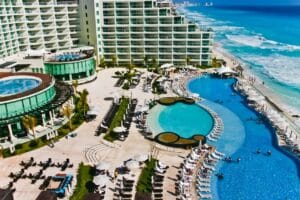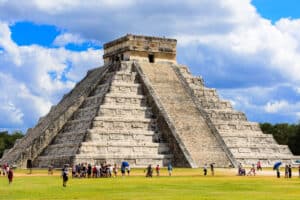Cancun’s seaweed season peaks in the summer, typically from May to August, which affects the conditions on the beaches in the area. After all, who wants to relax on a beach or swim with stinky seaweed floating around?
However, as of 2023, the seaweed forecasts promise good news for Cancun and its visitors. All 14 public beaches are basically seaweed-free — they’re in the “green” zone, which means super low seaweed levels. This is partly a result of Mexico really putting in the work to keep those beaches clean. They’re using barriers in the water and doing regular beach cleanups to make sure you have a fantastic beach experience.
Still, we want to give you a detailed overview of what you can expect if you’re visiting Cancun in seaweed season. If you want quick answers, head straight to “Cancun Sargassum Map: Are There Any Beaches to Stay Away From?” and ” Tips, Precautions & Alternatives for Seaweed Season in Cancun.
But if you want to learn all about what seaweed season means for you as a tourist while visiting Cancun, then reading the whole article will give you a lot of useful information!
Sargassum: The Ocean’s Floating Forests
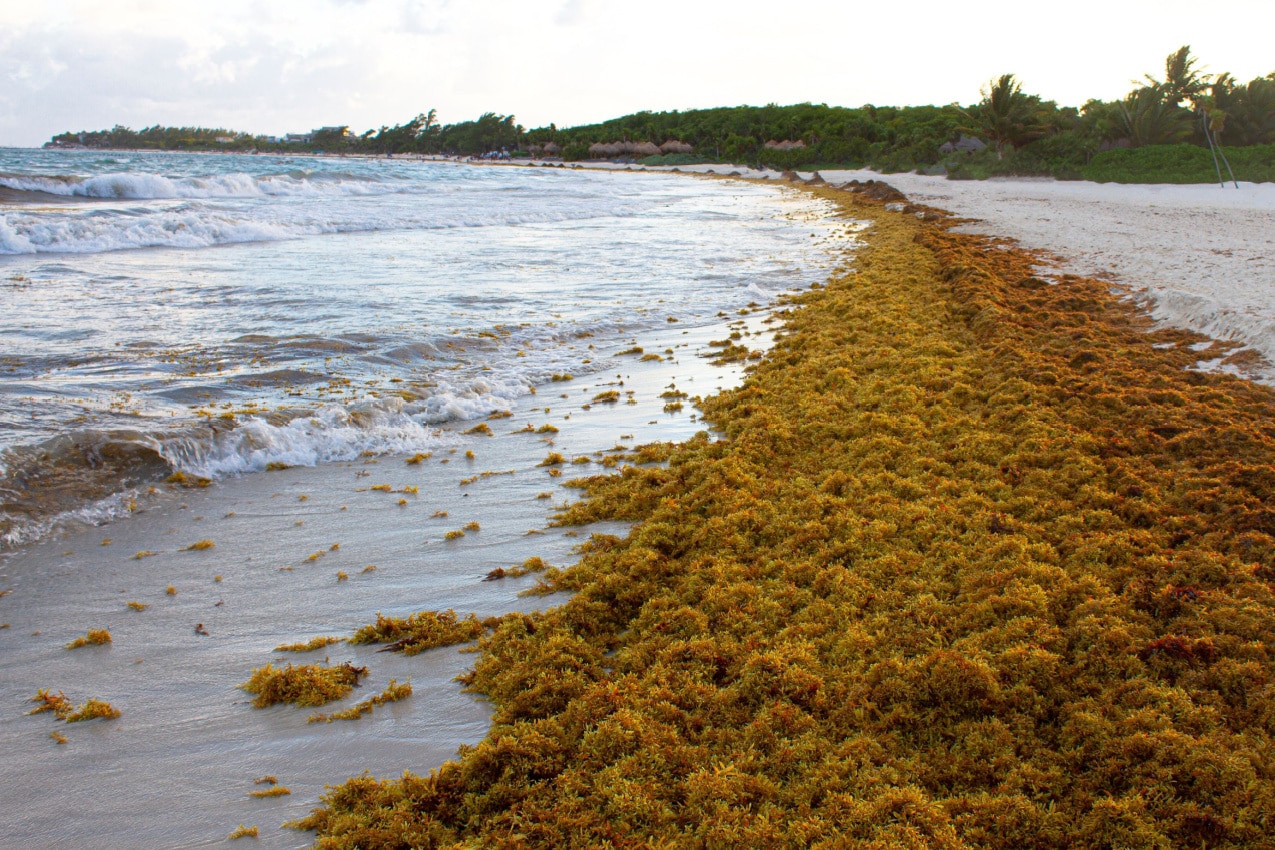
Sargassum is a brown seaweed that floats around on the surface of the ocean. It gets its name from the Spanish word “sargacinha,” which means “grape,” since it has grape-shaped air bladders that keep it aloft.
Christopher Columbus initially encountered sargassum in 1492 within what we now identify as the Sargassum Sea, an expanse of open ocean nestled within the Northern Atlantic Subtropical Gyre.
Fast forward to 2011, when remarkably strong winds and ocean currents inside the Sargassum first pushed this seaweed into the tropical Atlantic, announcing the beginning of the persistent seaweed problem in Mexico and its nearby regions.
Sargassum’s Dual Role — And What It Means for Tourists
Sargassum’s vital role in the ocean is to provide food, shade, and shelter to a variety of marine life, from fish and shrimp to crabs and turtles. It also has a high concentration of nitrogen, phosphate, and potassium, which makes it a great natural fertilizer.
However, when washed ashore, it can have a negative impact on the environment. Washed-up sargassum attracts insects, destroys sea turtle nesting sites, and causes fish die-offs. It also releases an unpleasant odor, making it difficult for guests to relax on particular beaches. Participating in water sports is also not an option near seaweed — you cannot swim, snorkel, surf, or ride a boat.
Is It Dangerous?
Sargassum isn’t hazardous for you when you’re in the water, so people can swim around it. The sole exception is when decaying sargassum begins to emit harmful gases such as hydrogen sulfide and ammonia, in which case it can cause skin irritations and breathing problems in persons with respiratory conditions like asthma.
Seaweed Season in the Atlantic: The Latest Updates and Predictions
The timing of Sargassum growth can vary from place to place. Satellite observations show that traditionally, the Sargasso Sea used to have more seaweed during the fall and winter months. However, since the 2011 migration to the tropical Atlantic, sargassum now tends to appear mostly during the spring and summer months, with the highest activity occurring in June or July and the lowest during the winter months.
In 2023, the seaweed season in Cancun had a rocky beginning, but as summer approached, the situation took a positive turn.
At the very start of seaweed season, in March, the sargassum forecast revealed a shocking 13 million tons of seaweed in the Great Atlantic Sargassum Belt, stretching from West Africa to the Gulf of Mexico. The forecasts predicted this would be the beginning of a massive seaweed invasion; however, by the end of May, this quantity had unexpectedly dropped by 15%.
As June arrived, the sargassum continued to decline, reaching a total wet weight of approximately 9 million metric tons. In July, this number dropped to around 6 million, with the highest concentration in the Central West Atlantic region (~4 million) and the Caribbean Sea, home to Cancun (~1.5 million).
By the end of August, the sargassum in this region had a total wet weight of 5 million metric tons. Most of the seaweed was concentrated in the Central West Atlantic region (~ 2.5 million) and the Caribbean Sea (~ 2 million). This is a slight increase in the Caribbean Sea compared to July, but according to the University of South Florida, this is typical for the time of year. The Gulf of Mexico also had minimal sargassum, which is also common during this season.
To provide a sense of scale, the Atlantic Ocean spans approximately 41 million square miles (106 million square kilometers). So, while 5 million metric tons may have localized effects, this quantity of seaweed makes up only a tiny proportion of the overall expanse of the ocean.
Currently, this seaweed is mostly evident at the Caribbean Sea’s northern and eastern borders (where Cancun is located), as well as slightly north of the Greater Antilles Islands. In the western Caribbean Sea, the sargassum is almost non-existent.
Looking ahead, the University of South Florida anticipates that the general quantity of sargassum in the Gulf of Mexico, Caribbean Sea, and Central West Atlantic will decrease even more, lessening the threat to coastal towns like Cancun.
However, because the route it takes is heavily influenced by winds and currents, it’s difficult to predict where this phenomenon will go next. For more information, visit the official website of the University of South Florida.
Mexican Caribbean Fights Back Against Sargassum: A $32.3 Million Effort to Keep Beaches Pristine
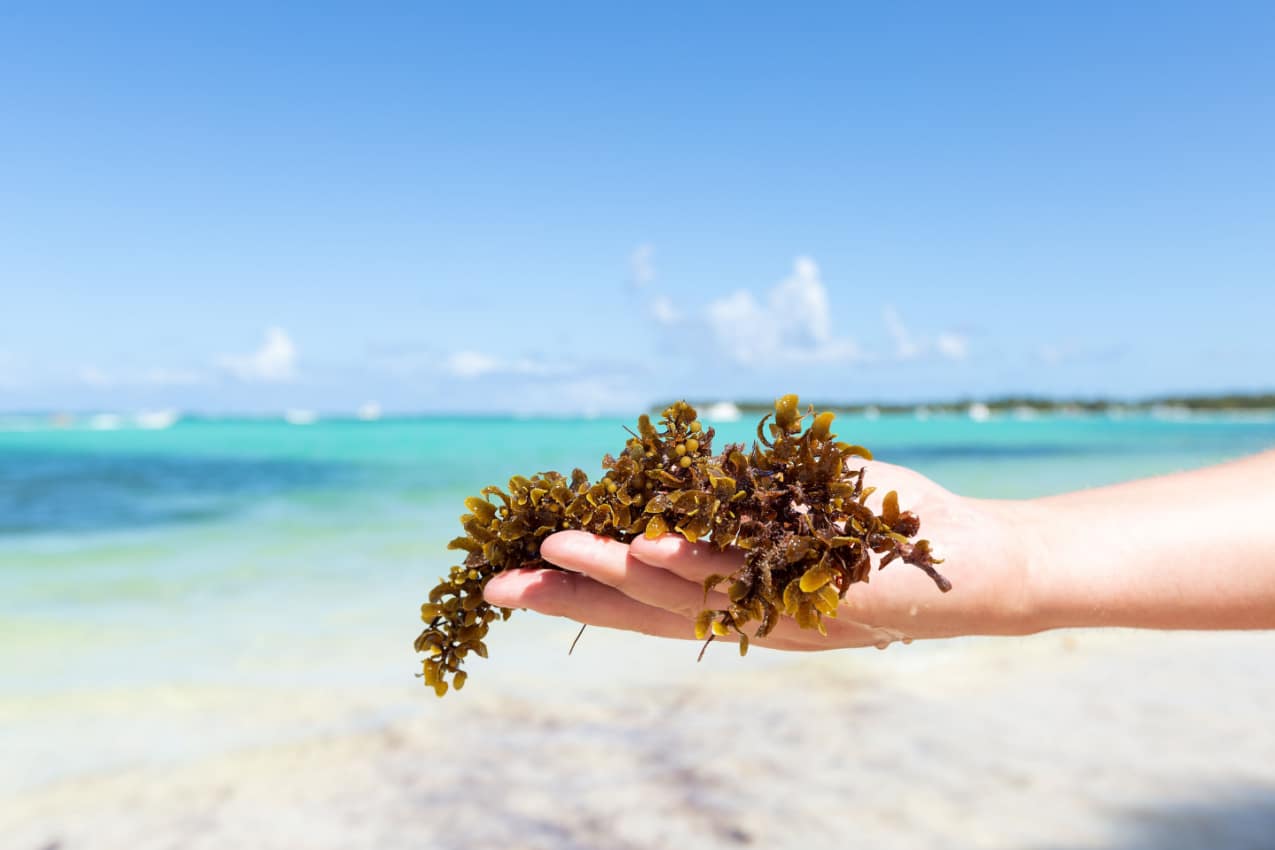
Sargassum is a real eyesore and, naturally, has a negative impact on tourism, so the officials are putting in considerable effort to keep the beaches clean and attractive.
The Mexican government has invested over 32.3 million pesos (~2 million dollars) in the prevention and clean up of sargassum in more than 73 beaches around the Mexican Caribbean.
A crucial part of the strategy is the installation of anti-sargassum barriers, with more than 9,000 meters (~29,691 feet) of these barriers already in place along the coast of Cancun, Solidaridad, Puerto Morelos, Tulum, and Playa del Carmen.
Additionally, there’s an ongoing operation involving 328 people and 16 boats dedicated to removing sargassum from the coastline. The Navy has also designated 11 specialized vessels to pick up sargassum in the Caribbean waters.
Furthermore, hotels and resorts in Cancun and other tourist destinations have established their own private operations. They’ve put $100 million into gathering sargassum from their coasts and converting it into biodiesel. This program has attracted substantial worldwide investment and interest from big firms such as Amazon and Microsoft.
Cancun Sargassum Map: Are There Any Beaches to Stay Away From?
As we learned so far, there was a full-blown sargassum invasion at the beginning of spring, however, the presence of the seaweed in the ocean drastically reduced over the summer, with positive predictions indicating it’s likely tol continue decreasing until the end of 2023.
As of September 2023, all 14 public beaches in Cancun are labeled as “green” in terms of seaweed levels — meaning “very low.” These beaches are Playa del Niño, Puerto Juárez, Playa Las Perlas, Playa Langosta, Playa Tortugas, Playa Caracol, Punta Cancun, Playa Gaviota Azul, Playa Chacmool, Playa Marlín, Playa Ballenas, Playa Delfines, Playa Punta Nizuc, and Playa Coral.
Very low levels of seaweed on beaches means there’s just a tiny bit of seaweed floating around, which is hardly noticeable and likely won’t hamper your beach experience. When the seaweed levels become more significant, beaches are categorized with either a yellow label, indicating ‘moderate levels,’ orange, indicating ‘abundant,’ and red, indicating ‘excessive amounts of seaweed.’
When a beach is 100% free from seaweed, it has a blue label. Although there isn’t a completely seaweed-free beach in Cancun, its next-door neighbor, the beautiful Isla Mujeres island, is abundant in them. Check out the map if you want to learn more.
The distance between Isla Mujeres and Cancun is roughly 5.5 miles (9-kilometer). You can visit it by taking a short ferry ride that will cost you from $10 to $20. The ferry ride from Cancun to Isla Mujeres typically takes around 15 to 20 minutes — so it’s quick, convenient, and budget-friendly!
So, if you want 100% sargassum-free beaches and clear turquoise waters, hop on a ferry and visit this beautiful island. Fun fact, not only is it known for being clear of seaweed, but it’s also one of the cheapest and safest places in all of Mexico (and definitely some of the most beautiful ones).
Tips, Precautions & Alternatives for Seaweed Season in Cancun
Sargassum season in Cancun usually lasts from spring to fall. However, it can be unpredictable in terms of how much seaweed there actually is.
Some days, the beach water may look brown and cloudy, while on others, it may look perfectly clear. This change is influenced by factors like waves, wind, and ocean currents.
Since it’s hard to predict, there’s no need to stress about the seaweed season in Cancun ahead of time. Instead, it’s better to get educated on what to do if you visit a beach in Cancun that is covered in seaweed.
Before you head out on your Mexican adventure, stay updated on the latest seaweed forecasts for Cancun — by consulting trustworthy sources like the Quintana Roo Sargassum Monitoring Network or the official website of the University of South Florida.
Decomposing seaweed, as we already explained, may cause irritation and breathing problems, so if you experience these symptoms while at the beach, it’s a good idea to leave the affected area and not visit it until you feel better. There are always lovely, seaweed-free beach alternatives at close distance. The lovely Isla Mujeres, for example, is the all-time shelter from the seaweed influx — and it’s only a ferry ride away.
On days when you aren’t in the mood for beach time and ferry rides, Cancun and the neighboring cities offer lots of intriguing attractions. You can see ancient pyramids, go on jungle trips to spot Mexican wildlife, and much more — we’ll give you some suggestions in the following section.
Another thing to remember is that seaweed can be home to a variety of marine organisms, some of which can cause painful stings or bites. Keep a safe distance from seaweed, and make sure your children understand this rule.
Also, if you live near the shore and notice an invasion of seaweed or unpleasant scents, such as those caused by rotting seaweed, keep your windows and doors closed to protect indoor air quality.
If you need to handle seaweed for any reason, it’s a good practice to wear gloves. This minimizes contact with potentially irritating or harmful substances that may be present in the seaweed.
In the event that you suffer serious breathing difficulties, seek immediate medical attention or dial 911. Breathing issues can be a significant medical emergency, especially for those suffering from asthma.
Exploring Cancun During Seaweed Season: Fun Activities to Do
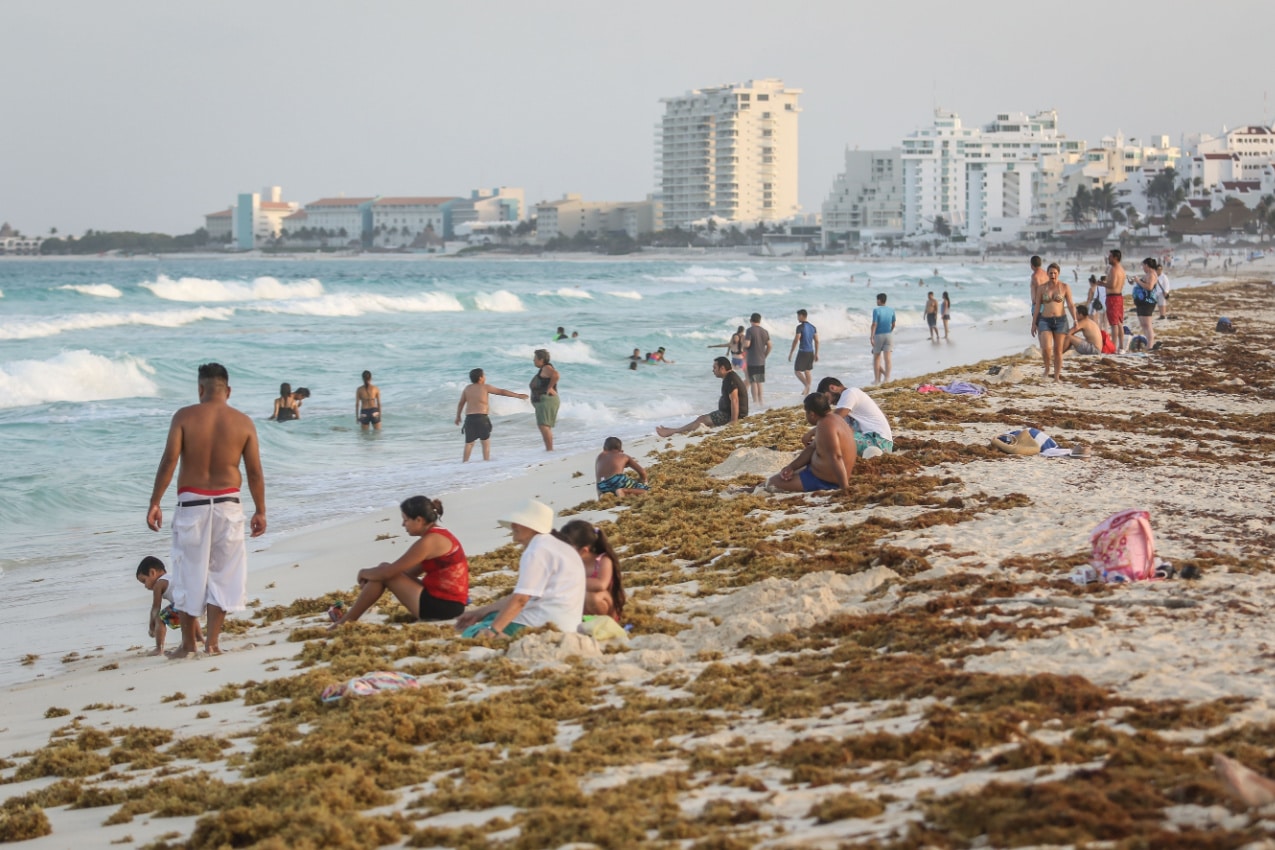
Here are some ideas on what to do when your favorite beaches in Cancun are not an option because of the seaweed situation.
Learn Mayan history. Cancun is surrounded by several ancient Mayan sites, each offering a unique glimpse into the rich history and culture of the region. Some of the most notable ones that are worth checking out are Tulum, Coba, Chichen Itza, Ek Balam, and El Rey Ruins.
Take a trip through the gorgeous Mexican rainforest. You can enjoy activities like ziplining, riding ATVs, spotting wildlife, or swimming in cenotes like Ik Kil Cenote and Dos Ojos Cenote. You can also check out Xel-Ha Park, a natural water park with a crystal clear lazy river amidst lush nature.
Experience the city. The “Hotel zone” in Cancun includes some of the most magnificent bars, seaside venues, and restaurants. You can enjoy Mexican cuisine and sip on a traditional Mexican beverage, like tequila.
Go shopping. Cancun has everything, from upscale stores to artisan booths selling Mexican handicrafts. So, don’t let the seaweed get you down — go boutique hopping to find something that will remind you of Cancun.
Enjoy a spa day. If all of the walking and activities exhaust you, you can always unwind in a spa center with a massage or facial.
Don’t Let Seaweed Deter Your Cancun Adventure
To summarize, Cancun had a rocky start to its seaweed season, but as the summer rolled on, the seaweed situation improved big time. All fourteen of its beaches have almost no seaweed (“green zone”), and just next door, Isla Mujeres is a seaweed-free paradise, with not a strand in sight.
And, at the end of the day, Sargassum is part of the ocean’s ecosystem. It comes and goes and can disappear overnight.
It’s definitely possible to have a satisfying stay in Cancun, even in seaweed season, if you’re flexible and have a plan B. Whether it’s visiting ancient sites or hiking in the jungle, there are tons of activities we’ve shared with you to keep you busy and entertained.
So, no — tourists shouldn’t cancel their trip to Cancun just on account of seaweed. Instead, they can choose to see the issue from a more positive standpoint. The government is addressing the problem, and there’s plenty more to do in Cancun than just relax at the beach.
We’re crossing our fingers that Cancun’s seaweed situation remains great. We wish you a fantastic time in Cancun!
Let us know if this sort of section is okay – we put it here because the article is quite comprehensive.
